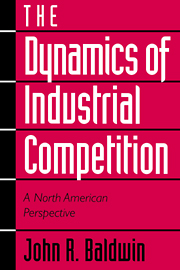Book contents
- Frontmatter
- Contents
- preface
- Acknowledgements
- 1 The dynamics of competition
- 2 Greenfield entry and closedown exit
- 3 Entry, exit, and the merger process
- 4 The rise and fall of incumbents
- 5 Patterns of large- and small-firm mobility
- 6 Plant turnover in Canada and the United States
- 7 Measures of market structure and the intensity of competition
- 8 The relationship between mobility and concentration
- 9 Turnover and productivity growth
- 10 Merger success
- 11 Turnover in domestic and foreign enterprises
- 12 Industry efficiency and firm turnover in the Canadian manufacturing sector
- 13 Firm turnover and profitability
- 14 Modelling entry
- 15 Conclusion
- Appendix A Measuring firm turnover – methodology
- Appendix B Definition of concentration and mobility measures
- Notes
- References
- Author index
- Subject index
4 - The rise and fall of incumbents
Published online by Cambridge University Press: 30 March 2010
- Frontmatter
- Contents
- preface
- Acknowledgements
- 1 The dynamics of competition
- 2 Greenfield entry and closedown exit
- 3 Entry, exit, and the merger process
- 4 The rise and fall of incumbents
- 5 Patterns of large- and small-firm mobility
- 6 Plant turnover in Canada and the United States
- 7 Measures of market structure and the intensity of competition
- 8 The relationship between mobility and concentration
- 9 Turnover and productivity growth
- 10 Merger success
- 11 Turnover in domestic and foreign enterprises
- 12 Industry efficiency and firm turnover in the Canadian manufacturing sector
- 13 Firm turnover and profitability
- 14 Modelling entry
- 15 Conclusion
- Appendix A Measuring firm turnover – methodology
- Appendix B Definition of concentration and mobility measures
- Notes
- References
- Author index
- Subject index
Summary
One tree will last longer in full vigour and attain a greater size than another, but sooner or later age tells on them all. Though the taller ones have a better access to light and air than their rivals, they gradually lose vitality, and one after another they give place to others.
Alfred Marshall (1920: 316)Introduction
The entry and exit of entire firms account for only part of the turnover that transfers market share from one firm to another. Entry occurs at the beginning of a firm's life, exit at the end. In the interim, infra-marginal change within the body of an industry occurs as incumbents grow and decline. In Chapters 2 and 3, the magnitude of entry and exit is described in detail. This chapter outlines the amount and pattern of turnover in incumbent firms – those that continue from one period to another – and compares it with the amount of turnover occasioned by entry and exit.
The amount of turnover can be expressed either in terms of absolute expansion and contraction in firm size or in terms of relative change such as shifts in market shares. In the first section, the pattern of change is examined using rates of growth and decline in firms defined at the level of the manufacturing sector as a whole; in the second section, the market share being shifted from those gaining to those losing relative position within a four-digit manufacturing industry is examined.
Appreciating the magnitude of the entry and exit process requires a comparison of instantaneous and cumulative rates of change.
- Type
- Chapter
- Information
- The Dynamics of Industrial CompetitionA North American Perspective, pp. 61 - 81Publisher: Cambridge University PressPrint publication year: 1995



